Rootstock Inventory Management
Introduction
Inventory management is a structured way of getting, storing, and selling inventory. It is a component of the supply chain that deals with managing and supervising purchases made by customers and suppliers, keeping track of stock storage, regulating the quantity of goods available for sale, and fulfilling orders.
Benefits of Inventory Management
This helps in handling the intricate accounting and recording tasks involved in transferring inventory into and out of locations by using inventory transactions. We can take the inventory out of place when we issue it. To reconcile a disparity between the number of items that are recorded at a place and the actual count, we usually move inventory from one area to another while adjusting.
Overview of Inventory Management with Rootstock:
The Inventory contains components, items purchased from suppliers, raw materials, factory-made goods, and final products.
Rootstock Inventory features are split into two main sections.
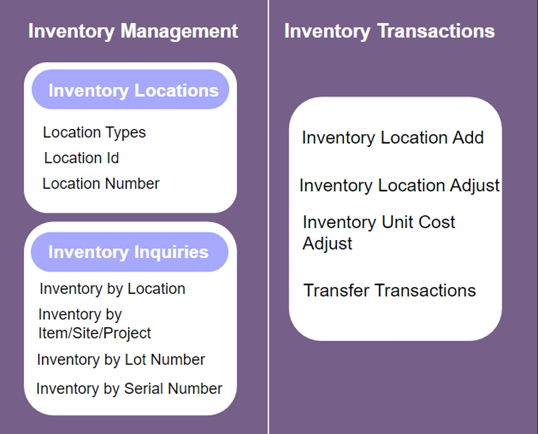
Fig. Inventory Management & Transactions
Inventory Management
Upon receiving the goods, they are logged into the system and assigned unique identifiers. Then, these items are stored in designated warehouse locations using location id and location numbers. When an order is placed, the system checks the available inventory and reserves the necessary items. Next, the items are picked from their respective locations and prepared for shipment. As the items are shipped out, the system automatically updates the inventory levels, ensuring real-time accuracy.
Rootstock offers seamless integration with external systems, enabling users to connect with carriers directly from the platform for shipping orders. Through API communication, carriers are promptly notified about shipments, facilitating pickup from the facility and subsequent delivery to the customer.

Fig. Inventory Management Process
Inventory Location ID
Inventory Location IDs within Rootstock are used to pinpoint specific locations where inventory is managed within a Division/Site. Every Site needs at least one Location ID, usually called "On Hand Inventory." These locations can be split further for better control, like indoor stockrooms or manufacturing floors.
Each Location ID decides what type of inventory is stored there, whether it's ready for orders or waiting to be dealt with. These IDs are made up of a code, description, and type, which determines if the inventory can be used for orders or not. Different types of locations exist, such as On Hand, Non-Nettable, and Consigned, each serving a different purpose. Also, certain indicators like 'Default Available for Picking' and 'Do Not Delete Zero-Qty Location' can be set up to handle inventory more effectively.
Inventory Location Number
The Inventory Location ID works with Location Numbers to fully identify where Inventory Items are kept. Location Numbers help define details like the row, aisle, shelf, and bin of the inventory.
These Location Numbers can be made as needed or set up beforehand for better organization. Whether a Location Number must be set before using it depends on the 'Location Number Required Indicator' on the Site Master record. If it's not turned on, you can enter Location Numbers freely when doing transactions.
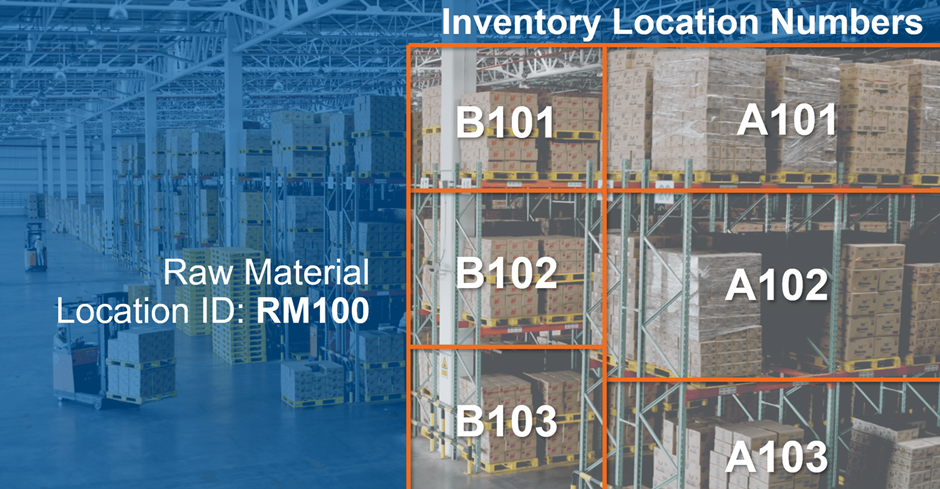
Fig. Inventory Location Numbers
Inventory Inquiries
Inventory can be viewed in different ways using the Inventory Management app's inquiries. Let's explore some common methods used to see inventory details.
Inventory by Location
This is used to track the inventory by its location in which the item has or had on-hand inventory. This shows where inventory is stored. Each location with an item has its own record, storing details like Location ID, Location Number, Item Number, Lot or Serial Numbers, and Quantity. If an item is in multiple locations, it appears multiple times in the list.
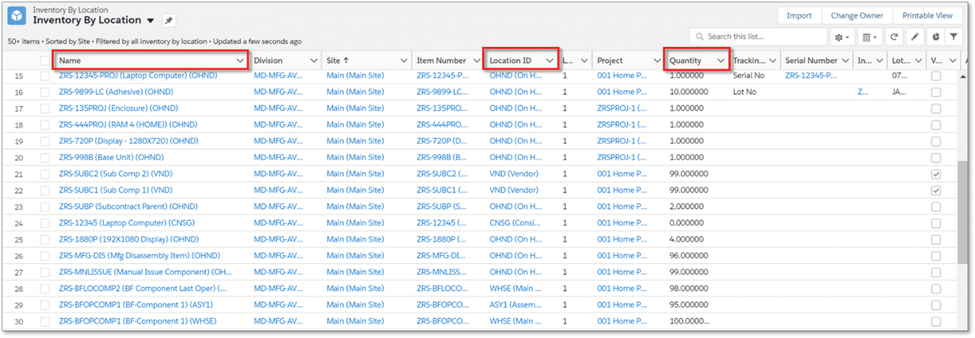
Fig. Inventory by Location List View
Inventory by Site
Another method to view inventory is by Site. This Inventory by Site record reveals that there are currently 20 units of Item ZRS-12345 located at Site 300 in an On-Hand location. It also stores information about inventory in Non-Nettable Locations, Customer-Owned material, and Vendor-managed material, with values shown as 0 if none exist.

Fig. Inventory by Site Salesforce Record
Inventory by Item/Site/Project
This offers details on Inventory locations and amounts inside Sites and Projects, as well as the item's availability within the Site and Project for allocation management, while Projects are active in a division.
Inventory by Lot Number
When a manufactured or acquired item needs to be traceable by means of a lot number, lot control is applied. In contrast to Serial Control, which only refers to a single item at a time, it allows for quantities higher than one for any given item number. It stores details like the Item Number, Lot addition date, expiry date (if applicable), and quantities categorized as Consigned, On-Hand, or Non-Nettable.
It shows details like the Item Number, Lot addition date, expiry date (if applicable), and quantities categorized as Consigned, On-Hand, or Non-Nettable.
Inventory by Serial Number
This provides permanent records for serialized items. Each record is unique by Item Number and Serial Number. It includes historical information such as reworks, shipments, returns, and associated features.
Inventory Transactions
Inventory Transactions assists in managing the recording and accounting tasks related to moving inventory quantities into and out of locations.
Although Inventory Item records can be edited and maintained, Inventory Transactions are permanent. Errors and adjustments are rectified by creating a corresponding transaction, and both the original and the corresponding transactions can be viewed in the transaction audit trail.
Inventory Location Add
The Inventory Location Add function is used to put Items into locations where they weren't before. It makes a new record for the Item in that location and lets the user put some of the Items there. This transaction also shows the costs that make up the unit cost. The Inventory Location Adjustment transaction should be used to add more material if there is already inventory at that location.

Fig. Inventory Location Add
Inventory Location Adjust
When we need to change the Inventory count in a specific location, we use the Inventory Adjust Transaction. This gives the user the option to identify a reduction in inventory as Scrap. The Adjust Option field provides a list of transaction adjustment possibilities, including Adjust Qty Up or Adjust Qty Down.
Inventory Transfers
Inventory Transfer transactions are used when we need to move inventory for an item between different divisions, sites, locations, or projects. These transactions can be made by using the Inventory Transfer button found in the Inventory by Location List View. As Rootstock cloud ERP Partners, we would like to highlight each type of transfers
Division to Division Transfer
We use this transaction to move inventory between divisions within the same company. For instance, if Division B needs an item that Division A has in stock, we can transfer it. Simply select the inventory record to be transferred from the list view, and then choose 'Inventory Transfer.'
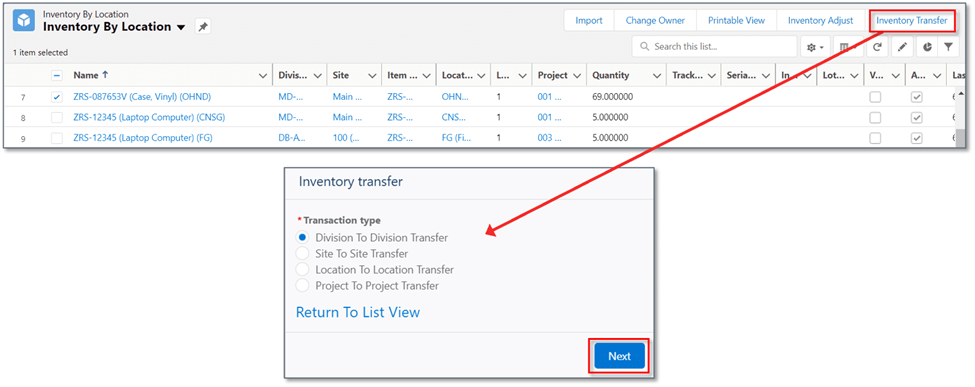
Fig. Inventory by Location List View for Division-to-Division Transfer
Other inventory transfers can be performed from this flow as well, including:
Site to Site Transfer
This is used to move Inventory from one site to another within the same division. When we perform this transaction, the stock location ID and/or number may change.
Project to Project Transfer
This is used when Inventory for an item needs to be moved from one project to another. For instance, if a project is running low on Inventory, it can be obtained from another project.
Location to Location Transfer
This is used when Inventory for an item needs to be moved from one location to another within the same division, site, and project.
Summary
The inventory management system of Rootstock ERP provides robust tools for precise tracking and organization of inventory, enhancing operational efficiency for manufacturers, distributors, and supply chain companies. Inventory inquiries enable users to access crucial inventory details such as location, quantity, and historical data, facilitating informed decision-making and optimized inventory management.
Inventory transactions, including additions, adjustments, and transfers, are integral components of Rootstock's inventory management solution. These functionalities allow for seamless management of inventory movements within and across divisions, sites, and projects. By leveraging inventory transfers, organizations can efficiently move inventory between different locations, ensuring optimal resource allocation and streamlined operations.
Recent Blogs

Master Power Automate Desktop: Guide to Automation
Read More
A Deep Dive into NetSuite Reporting Tools
Read More
Salesforce Data Migration Tools and Their Usage
Read More
Signal Chain Categories to Improve Customer Business using Rootstock
Read More
Master .NET Aspire: Level Up Your .NET Skills
Read More
Safeguarding Salesforce - Uncovering and Addressing Security Vulnerabilities
Read More
Mastering Amortization Flow in NetSuite
Read More
Demystifying Second-Generation Managed Packages (2GP) in Salesforce
Read More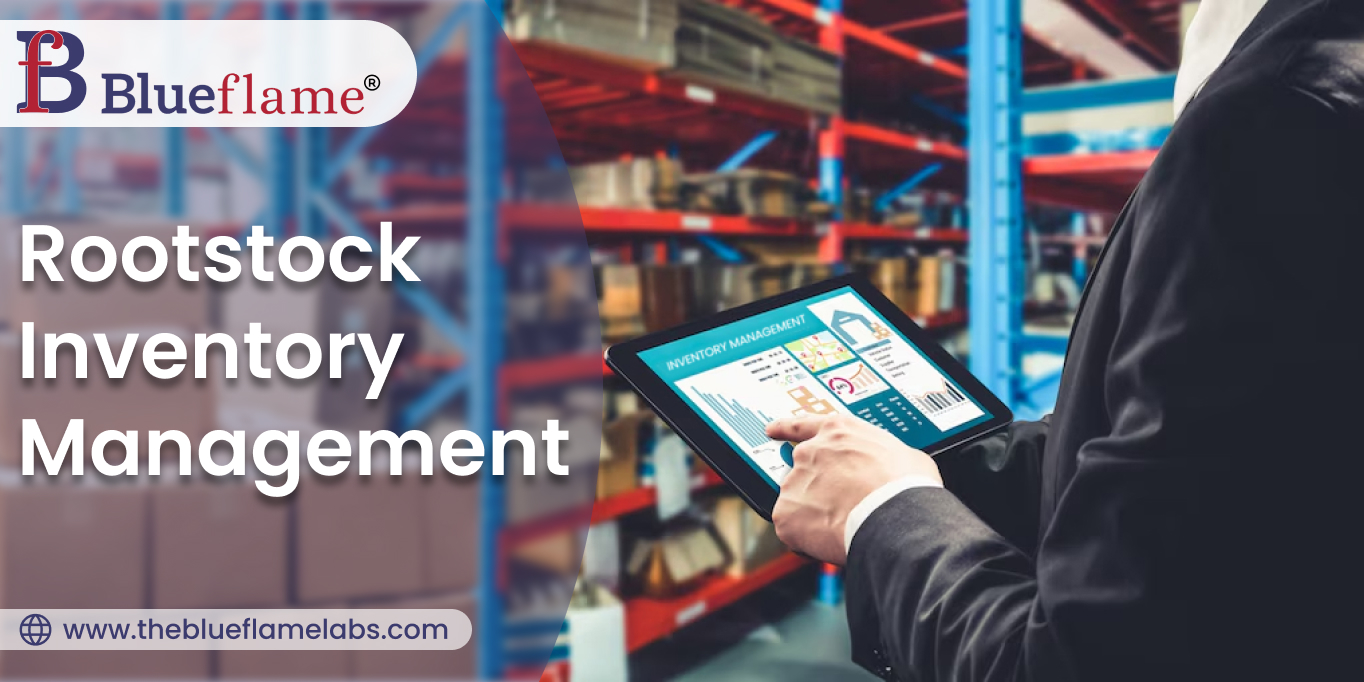


 Strictly Necessary Cookies
Strictly Necessary Cookies